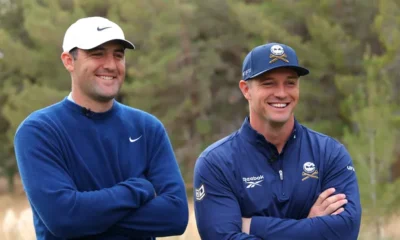Blog
You Probably Didn’t Know These 18 Facts About Jon Rahm

Jon Rahm was already one of the biggest stars in golf before his career-defining victory at the U.S. Open. The 26-year-old Spaniard’s birdie-birdie finish was the perfect punctuation mark on Rahm’s first major title.
You know Rahm for his elite off-the-tee game (second on tour); representing Europe at the 2018 Ryder Cup, where he defeated his idol, Tiger Woods, in Sunday singles; and maybe his on-course temper. But we bet you might not know these other 18 things about the first Spanish champion in U.S. Open history.
Rahm credits the 1997 Ryder Cup as being huge for getting his family into golf.
Rahm’s father, Edorta, had never played golf or seen it in person until the Ryder Cup came to Valderrama in 1997. Rahm says he started playing and got lessons when he was 6 or 7 years old.
Among the other sports Rahm tried as a kid in Barrika, Spain, was Kung Fu.
Rahm says he played five sports up until he was 14 years old (soccer, canoeing, Jai alai, golf and Kung Fu). Rahm was a fan of martial arts movies as a kid, and when one of his friends started doing Kung Fu, he got into it.
Rahm’s local coach, Eduardo Celles, started working with the Spaniard when he was 13, and he encouraged him to shorten his swing.
Rahm explains that he struggled with accuracy as a junior but still hit it farther than anyone else. Celles encouraged him to shorten his backswing for more control, and to this day, Rahm has one of the shortest backswings on tour.
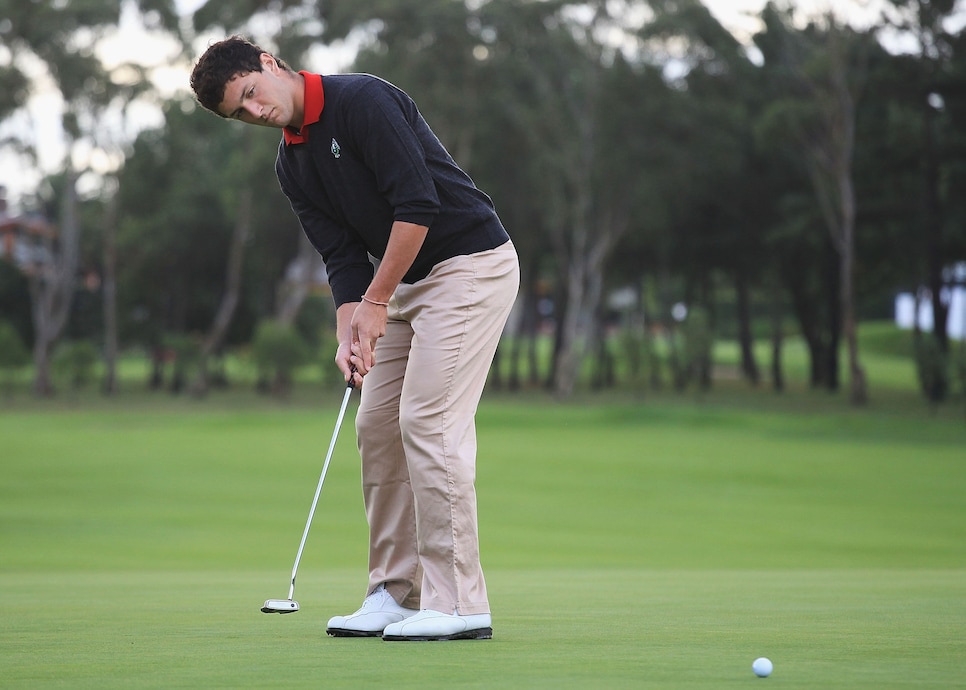
Matthew Lewis/R&A
He had never been to the United States—and spoke almost no English—before arriving in Tempe, Ariz., in fall 2012 to enroll at Arizona State.
Phil Mickelson’s brother, Tim, was the men’s golf coach at the time, and recruited Rahm when the Spaniard had very few offers. Rahm had to rush to take the SATs and verify his qualifications before being eligible at Arizona State in the fall, just a few months after Mickelson contacted him.
Tim Mickelson gets credit from Rahm for helping him learn English: Mickelson would make him and another Spanish-speaking teammate do 10 burpees for every Spanish word they used.
Though Rahm has said that learning the lyrics to rap songs helped him pick up slang and other English phrases not taught in a class, he says the rap part was exaggerated by the media after his win at the 2017 Farmers Insurance Open. He does cite Kendrick Lamar’s “Swimming Pools” and Eminem’s “Love the Way You Lie” as songs that particularly helped.

As a junior, Rahm earned a sponsor’s invitation into the 2015 Waste Management Phoenix Open and finished T-5.
It was the first time since Chris Wood’s T-5 at the 2008 Open Championship that an amateur finished T-5 or better in a PGA Tour event. And Rahm was just the second amateur to finish in the top five on tour since Justin Rose’s T-4 at the 1998 Open.
Jon Rahm in college.pic.twitter.com/7SHZDzX9gA— GOLFTV (@GOLFTV) June 21, 2021
Rahm became the first multiple-time winner of the Ben Hogan Award, which honors the best player in college golf.
He also rose to the No. 1-ranked spot on the World Amateur Golf Rankings, having amassed 11 tournament victories at Arizona State, the second-most in school history (trailing only Phil Mickelson). Despite the success in pro events as an amateur, Rahm stayed four years at ASU—as a promise to his parents.
Following a T-23 at the 2016 U.S. Open—where he was the only amateur to make the cut—Rahm turned professional.
In just seven starts over the rest of the 2016 season, Rahm finished T-2 at the RBC Canadian Open, T-3 at the Quicken Loans (his first pro start) and collected just a little more than $1 million in on-course earnings.
Rahm treated himself to a Porsche with those on-course earnings in the fall of 2016.
He told Golf Digest then: “It’s good for me to see it, wake up every day and see what I’ve accomplished the last eight years.”
The Spaniard showed up to our last shoot with him in 2019 in a shiny Arizona State-maroon Mercedes AMG G 63.
In addition to being Rahm’s college coach, Tim Mickelson was also Rahm’s agent after the Spaniard turned pro.
Mickelson left his head coaching position at ASU in 2017 to pursue an agent career at Lagardere Sports, representing Rahm until Phil Mickelson asked his brother to become his caddie.
Jon Rahm met his wife, Kelley Cahill, at Arizona State—where she was on the track and field team and threw javelin.
Rahm proposed to his college sweetheart while hiking near Torrey Pines in 2018 prior to the U.S. Open. And Rahm had the ring custom-built, as he told Golf.com in 2018: “I designed it. So Brian Stuard’s [wife] is a jeweler and is a really good friend of ours. So Kelley was talking to her. She knew what Kelley wanted, but I had my own ideas. Basically, with her help, I designed the ring. She wanted to pick the diamond, but I knew what I wanted. I designed what’s around the ring. It’s supposed to look like a crown and an engraving inside. I had a big part in it.”
The two got married in December 2019 in Bilboa, Spain.
The ceremony was in the Basilica de Begoña in Rahm’s hometown.
With his wife, Kelley, due to give birth to their first son in April 2021, Jon vowed to withdraw from the Masters if she went into labor during the tournament.
Jon never had to follow through on the promise as Kepa was born a few days prior to Augusta. And though his son was just 10 weeks old when Dad won the U.S. Open, Rahm remarked: “he won’t remember this … but I do.” Rahm will get to tell his son all about it one day.
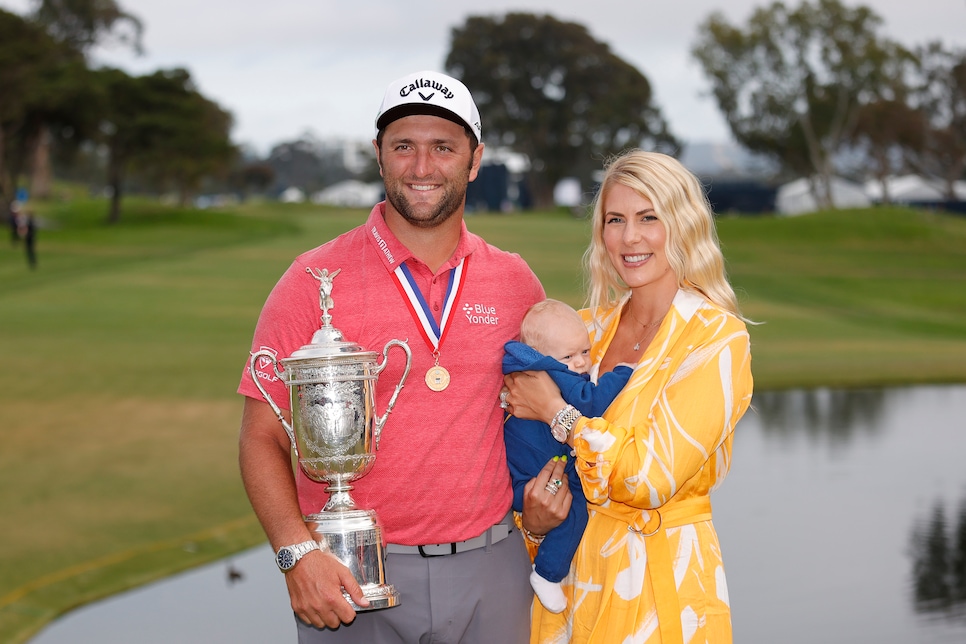
Known for showing his emotions on the course, Rahm credits a shift mentally on Sunday at the 2021 PGA in being calmer on the course.
He said about that shift over the past month: “I still had that grit, but it was almost like each miss bothered me less. I couldn’t tell you why.” Perhaps that’s fatherhood adding that, you know, perspective.
He has worked on his temper with a mental coach, Joseba Del Carmen, who used to be a bomb-disposal expert.
Rahm told Golf Digest this in 2019: “I used to think that golf is my life, that it’s who I am. [Del Carmen] was the first person to make me realize that it’s not, and that golf and life are very similar. The happier I am in life, the better I’m going to play. But I’m much more interested in raising a family and being a good husband and father than I am in golf. Don’t get me wrong—I want to be the best golfer I can be. If I had a gun to my head and had to choose between having only one or the other, I wouldn’t pick golf. I hope people don’t take that as me thinking I’d quit, but I’d choose family every time.”
On Saturday at the Memorial, Rahm had opened up a six-shot lead when he was forced to withdraw after testing positive for COVID-19.
Rahm was told by PGA Tour officials immediately after stepping off the 18th green on Saturday, and the scene unfolded while TV cameras were still running—capturing an emotional Rahm on TV. To his credit, Rahm said before the U.S. Open he did not fault the PGA Tour for how it was handled—a sentiment he reiterated in his post-round interviews.
This is not the first time Rahm has earned the No. 1 spot in the Official World Golf Rankings.
The Spaniard first ascended to the top spot after winning the 2020 Memorial last July. He was ranked No. 1 for two weeks before Justin Thomas surpassed him, then Rahm retook the No. 1 ranking for two more weeks before Dustin Johnson was ranked No. 1 for the past 43 weeks.
The $2.25 million first-place prize Rahm earned at the U.S. Open gives the Spaniard more than $28 million in PGA Tour on-course earnings.
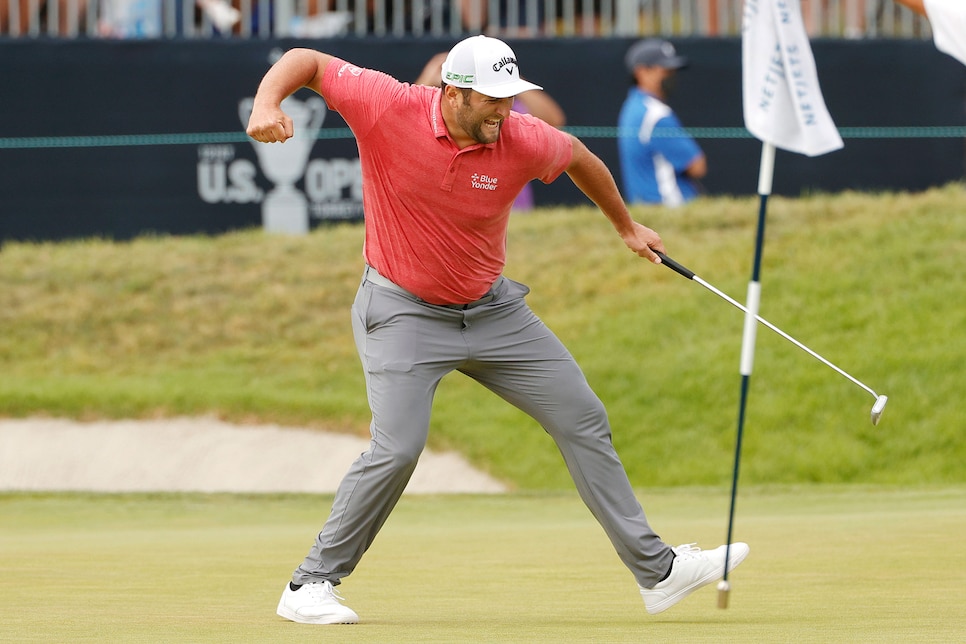
Ezra Shaw
In addition to Rahm’s six PGA Tour victories, he also boasts six European Tour titles—amassing more than 6.4 million euros for those wins.
This article originally appeared on Golf Digest.
Blog
Sustainability in Golf: The Future of Eco-Friendly Greens
Read about the environmental impact of golf courses.
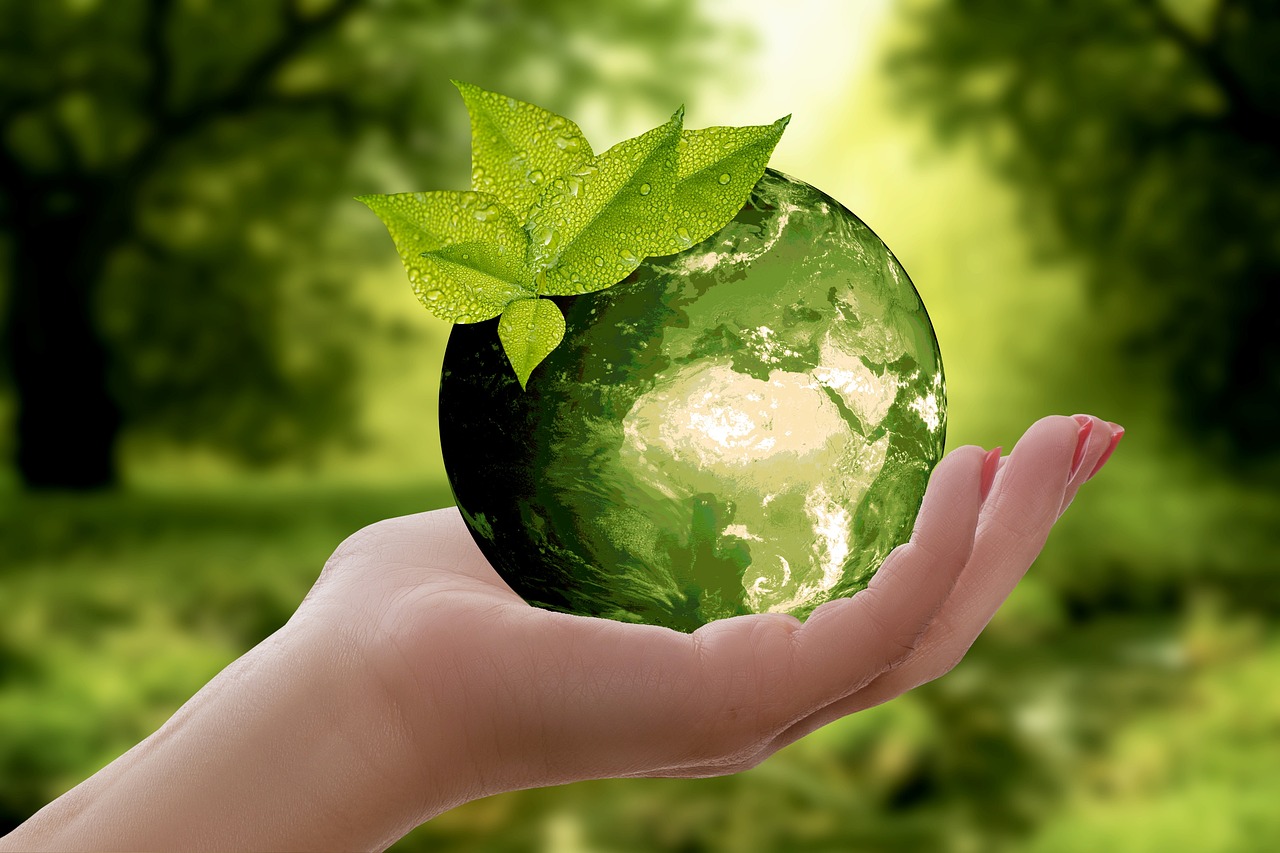
Golf, a sport often associated with pristine, manicured greens and lush landscapes, isn’t historically perceived as eco-friendly. However, with growing concerns about climate change and sustainability, the golf industry is steadily transitioning towards more sustainable practices. This article will explore how golf courses around the world are becoming greener and more eco-friendly while maintaining their appeal to golf enthusiasts.

The Environmental Impact of Golf Courses
Golf courses traditionally use extensive resources, including water, pesticides, and fertilizers, which can have detrimental effects on the environment.
-
-
- Water Usage: Maintaining the verdant landscapes of a golf course requires enormous amounts of water. This is particularly concerning in regions where water scarcity is a significant issue.
- Pesticides and Fertilizers: To keep golf courses lush and free of pests, large amounts of chemicals are often used. These substances can seep into the ground, polluting water sources and harming local wildlife.
- Habitat Disruption: Golf courses often displace natural habitats, upsetting local ecosystems and reducing biodiversity.
-

Green Initiatives in Golf: Sustainability on the Fairways
Recognizing the environmental impact, many golf courses are now implementing sustainable practices to reduce their ecological footprint.

Water Conservation
Water conservation is a significant focus in eco-friendly golf course design. Methods employed include:
-
-
- Recycled Water: Many golf courses are now using recycled water or rainwater for irrigation, significantly reducing the use of freshwater resources.
- Drought-resistant Grass: Some courses are opting for drought-resistant varieties of grass that require less watering.
- Irrigation Technology: Advanced irrigation systems can efficiently distribute water, minimizing waste.
-
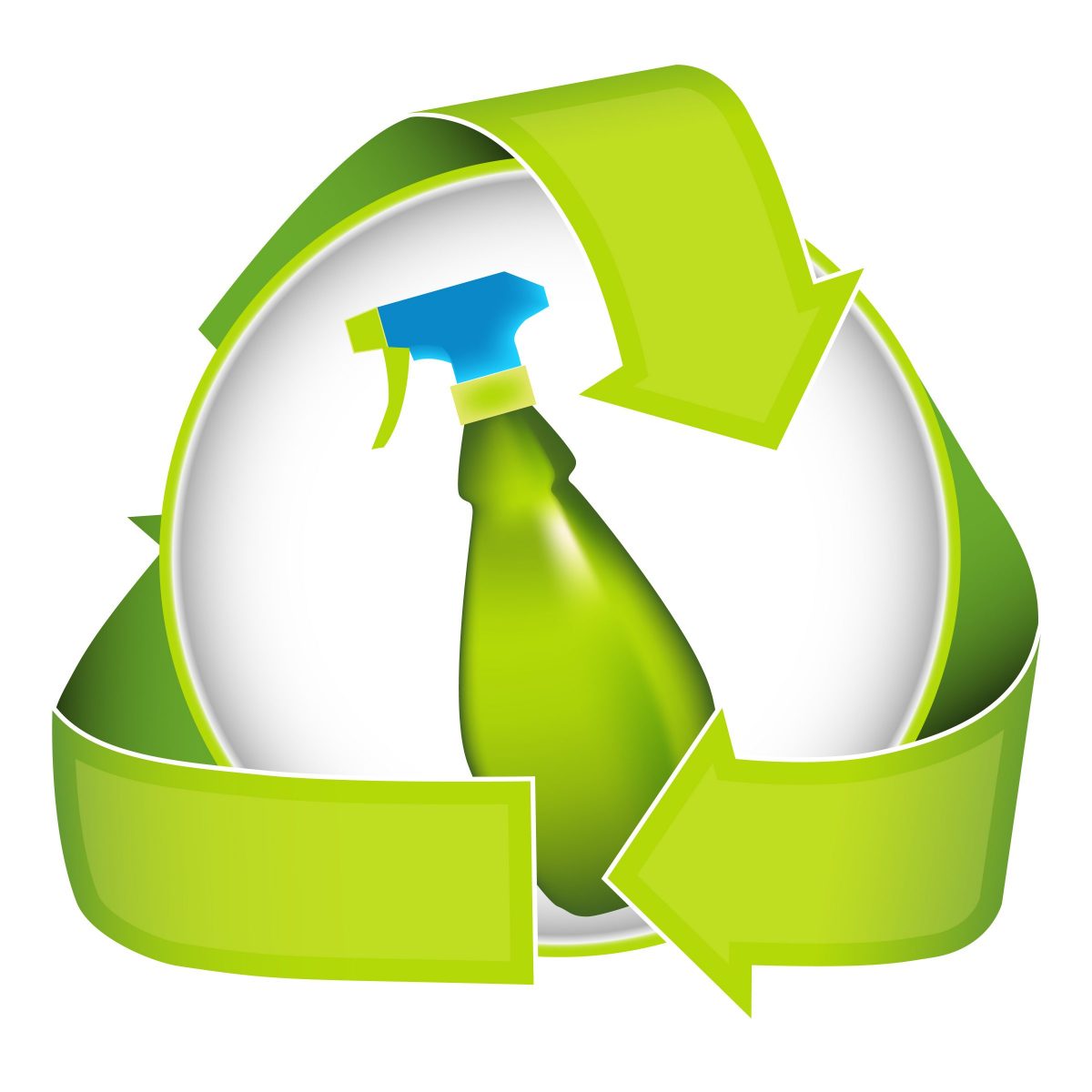
Reducing Chemical Usage
Reducing the use of harmful chemicals is another crucial step towards sustainability in golf. This can be achieved through:
-
-
- Organic Fertilizers and Pesticides: Many golf courses are switching to organic alternatives, which are less harmful to the environment.
- Integrated Pest Management: This approach focuses on long-term prevention of pests through biological control and habitat manipulation, reducing the need for chemical pesticides.
-

Preserving Local Habitats
Golf courses are increasingly being designed to coexist harmoniously with local ecosystems. This involves:
-
-
- Preserving Natural Features: Instead of altering the landscape to fit the course, designers are now incorporating existing natural features into the design.
- Creating Wildlife Habitats: Some golf courses are creating habitats for local wildlife, promoting biodiversity.
-
Case Studies: Sustainable Golf Courses Around the World
There are several golf courses worldwide that serve as excellent examples of sustainability in the industry.
- Pebble Beach Golf Links, USA: This renowned golf course uses recycled water for irrigation, reducing its freshwater use by 50%.
- St Andrews Links, Scotland: Known as the “Home of Golf”, St Andrews Links has implemented an extensive environmental management plan, including water conservation, habitat protection, and the use of organic fertilizers.
- Vineyard Golf Club, USA: This golf course in Massachusetts is one of the first to become fully organic, using only organic fertilizers and pesticides.
The Future of Sustainable Golf
The golf industry’s move towards sustainability is not just about eco-friendly practices on the course. It’s also about educating players and visitors about the importance of sustainability, thus promoting a culture of environmental consciousness.
While the transition to greener practices may be challenging, the benefits are immeasurable. Sustainable golf courses not only help protect the environment, but they can also enhance the playing experience, offering golfers the chance to play their favorite sport while surrounded by thriving, natural landscapes.
In conclusion, as awareness of environmental issues continues to grow, the question of “how green can the greens get?” is being answered by golf courses worldwide. Through innovative practices and a commitment to sustainability, the future of golf looks set to be greener than ever. As players, supporters, and enthusiasts of the sport, we can all contribute to this positive change by supporting golf courses that prioritize sustainability and by advocating for green practices within the golfing community.
Blog
The Golfer’s Holiday Hint-Dropping Guide
Your spouse thinks you want socks. You want a new driver. Here’s how to fix that.

Because subtlety is overrated when there’s a new driver on the line
Your spouse thinks you want socks.
Your kids think you want a tie.
Your mother-in-law is convinced you’d love another sweater with a reindeer on it, even though you’ve worn the last three exactly never, and everyone knows it, but somehow this year will be different.
It won’t be.
Here’s the problem. You want golf stuff. They don’t know what golf stuff means. You say “rangefinder” and they hear “robot finder.” You mention “premium golf balls” and they think all golf balls are the same, which is adorable but wrong, and you can’t exactly explain that without sounding like a crazy person who cares too much about dimple patterns.
So you need a strategy.
Not a subtle one either. Forget dropping hints like breadcrumbs. Drop them like anvils. We’re talking about a systematic campaign of suggestion, repetition, and strategic device-leaving that would make Madison Avenue jealous.
The Laptop Strategy (For the Tech-Savvy Golfer)
Leave your laptop open. Always. But not to just anything.
Open to golf retailer websites with items in your cart. Specific items. With the size, color, and model number clearly visible. And here’s the key – leave it open on the kitchen counter where your spouse makes coffee, because everyone looks at screens while waiting for coffee, it’s basically a law of physics at this point.
Do this for three weeks straight. Different items, same cart. They’ll get the message. And if they don’t, you’ve got a backup plan because you can just buy it yourself on December 26th when everything goes on sale.
The Casual Mention Method
This requires finesse.
Not too much though.
The goal is to work golf gifts into every conversation without seeming obsessed, which you are, but they don’t need to know that. Your daughter mentions her science project? “Speaking of projects, I’ve been thinking about upgrading my wedges.” Your son talks about his basketball shoes? “Funny you mention shoes – golf shoes with better traction would really help my game.” The mailman asks how you’re doing? “Great, though I’d be better with a new putter.”
Is this overkill? Maybe. Will it work? Absolutely.
The Magazine Massacre
Buy every golf magazine on the newsstand. Dog-ear the pages. Circle items in red pen. Write notes like “This would be perfect!” and “Honey, look at this one!” and leave them everywhere – the bathroom, the nightstand, the kitchen table, the car, their car, basically anywhere someone might sit for more than thirty seconds.
When they ask why there are seven golf magazines in the living room, just smile and say you’re “doing research.” Research for what? They won’t ask. They’re too busy looking at all those circled items with price tags helpfully highlighted.
The Strategic Screenshot
Text them screenshots. Daily.
“Look at this cool driver!” Send.
“These gloves are on sale!” Send.
“Remember when I mentioned wanting new golf shoes? These are the ones.” Send with three heart emojis because you’re not a monster, you still care about the relationship, you just also care about having the right equipment to shave three strokes off your game.
It’s called balance.
The Gift List That’s Not a Gift List
Create a shared note on your phone called “Gift Ideas” and fill it exclusively with golf items. When they ask what you want for Christmas, just say “Oh, I don’t know, I’m easy to shop for!” and then casually mention you made a little list of ideas, you know, just in case they needed inspiration, no pressure, but it’s organized by price range and includes links.
This works because you’re giving them exactly what they want – a clear shopping list – while maintaining the illusion that you’re being flexible. You’re not. But they don’t need to know that until after the presents are wrapped.
The Buddy System
Recruit your golf buddies. Have them “accidentally” call when your spouse is around. Make sure they loudly discuss the new equipment they just bought and how much it’s improved their game. Your spouse will hear. They’ll connect the dots. And if they don’t, have your buddy call again tomorrow. And the next day. Eventually, either your spouse will buy you golf stuff or they’ll buy you a different phone number, and honestly, both outcomes have their merits.
The Amazon Wish List Blitz
Create an Amazon wish list. Share it with everyone. Your spouse, your kids, your parents, your siblings, your coworkers, that guy you met at the driving range once, everyone.
Put forty items on it. Thirty-eight should be golf-related. The other two? A book and a candle, just so you seem reasonable and well-rounded, which you’re not, but again, they don’t need to know that.
Update it weekly. Add reviews in the comments like “Would really help my slice” or “These are the exact ones my pro recommended.” Make it impossible for them to buy anything else because everything else looks boring compared to golf equipment that promises to transform your game, which it might not, but the promise is what matters here.
The Direct Approach (For the Brave)
Just tell them.
Seriously.
Sit them down. Look them in the eyes. Say “I want golf stuff for Christmas. Specifically, I want this driver, these balls, and this rangefinder. Here are the links. Here are the specs. I’ve made it as easy as possible. Thank you for listening to my TED talk about my golf needs.”
Will they appreciate the honesty? Probably. Will you get what you want? More likely than if you kept hoping they’d telepathically understand that you need a new sand wedge because the grooves on your current one are worn down and it’s affecting your bunker play, which is already bad enough without equipment issues.
The Follow-Up Campaign
Don’t stop after dropping hints. Follow up. “Did you see that text I sent about the driver?” Ask during dinner. “Remember those golf shoes I mentioned?” Ask during breakfast. “Still thinking about that rangefinder.” Say it to no one in particular while watching TV.
Repetition is your friend. Marketing people know this. Politicians know this. Now you know this. Say it enough times and it stops being a hint and starts being a fact – you want golf stuff, they know you want golf stuff, and somewhere in the back of their mind, they’re starting to accept that golf stuff is happening this year.
The Backup Plan
Here’s the truth – they might still get it wrong. They might buy you golf-themed pajamas when you wanted golf balls. They might get you a gift card to a mini-golf place when you wanted a membership to a real course. They might wrap up golf socks, which are fine, but they’re not the GPS watch you’ve been talking about since July.
It’s okay. Say thank you. Mean it. Then on December 26th, hit those post-Christmas sales like a bargain hunter who knows exactly what they want and has been planning this shopping trip since Thanksgiving.
Because you have been.
And that’s fine. Golf equipment is expensive. If waiting one more day means you can get 40% off that driver you’ve been eyeing, that’s called being financially responsible. Your spouse will appreciate it. Eventually. After you explain why you needed three new wedges when you already have wedges.
“The grooves,” you’ll say.
They won’t understand.
But you’ll have new wedges.
The Real Gift
Look, here’s what matters. The holidays aren’t really about getting the perfect golf equipment, even though that would be nice, and you’ve spent considerable mental energy making sure everyone knows exactly what you want.
The holidays are about spending time with people you love. Even if they buy you reindeer sweaters. Even if they think all golf balls are the same. Even if they wrap up golf socks when you desperately need new grips for your irons.
They’re trying. That counts for something.
But also, leave your laptop open to that golf retailer website. Just in case. Because trying is good, but specific product links are better, and you didn’t make it this far in the season without having a solid Plan B.
Happy holidays. May your drives be long, your putts be true, and your gift-givers be observant enough to notice the forty-seven hints you’ve dropped since October.
And if all else fails?
There’s always next year.
Blog
Unveiling the History and Symbolism of Iconic Golf Trophies
Golf is a sport steeped in tradition, prestige, and class. From the lush greens of the course to the meticulously designed clubs, each aspect of the game exudes a sense of history and elegance.
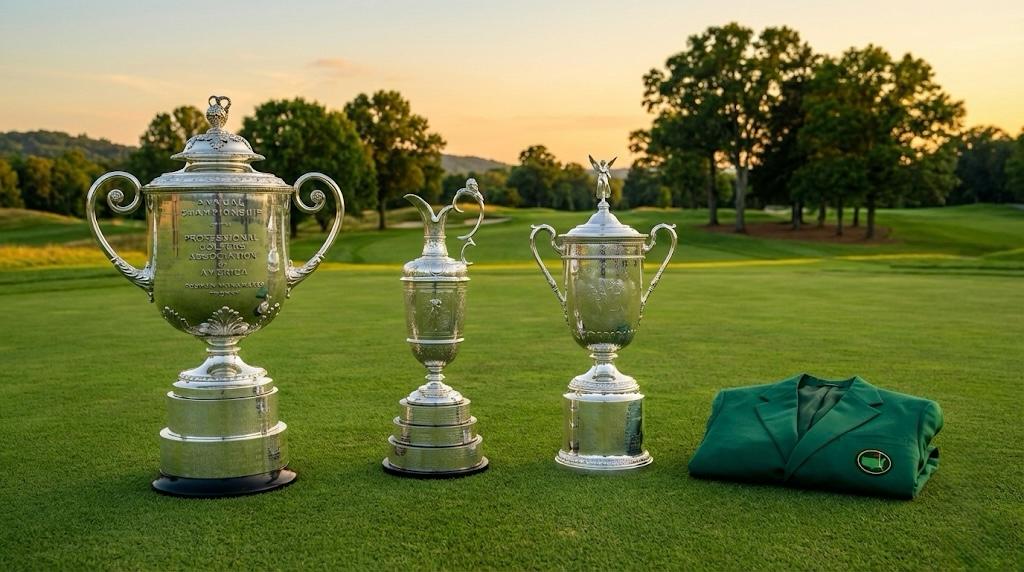
Golf is a sport steeped in tradition, prestige, and class. From the lush greens of the course to the meticulously designed clubs, each aspect of the game exudes a sense of history and elegance. Among these elements, golf trophies – the coveted prizes of the tournament – hold a special place. These iconic awards not only represent the winning golfer’s skill and determination but also carry a rich history and meaningful symbolism. In this article, we’ll delve into the story behind some of the most iconic golf trophies and what they symbolize, offering a unique perspective on this beloved sport.
The Claret Jug: The Open Championship
The Claret Jug, officially known as The Golf Champion Trophy, is awarded to the winner of The Open Championship, one of the four major championships in professional golf. The trophy, first presented in 1873, replaced the original prize of a red leather belt with silver buckle.
Its design is based on the medieval ‘claret jugs’ used to serve wine. The symbolism here lies in the association of the jug with a time-honored tradition, reflecting the essence of the tournament itself. The names of all the previous winners are inscribed on the jug, creating a tangible link to the history of the sport.
The Green Jacket: The Masters Tournament
At The Masters Tournament, one of the most prestigious events in golf, the winner is honored with a distinctive green jacket. The tradition began in 1937 when members of the Augusta National Golf Club wore green jackets to distinguish themselves from the crowd.
The symbolism of the Green Jacket is twofold. Firstly, it represents membership of an exclusive club, as only winners of The Masters or members of the Augusta National Golf Club are entitled to wear it. Secondly, the green color reflects the lush, pristine condition of the golf course, a crucial aspect of the sport.
The Wanamaker Trophy: PGA Championship
The Wanamaker Trophy, awarded to the winner of the PGA Championship, is named after Rodman Wanamaker, who played a significant role in establishing the Professional Golfers’ Association of America. It’s one of the largest trophies in professional golf, standing nearly 2.5 feet tall and weighing 27 pounds.
The size and weight of the Wanamaker Trophy symbolize the magnitude and prestige of the tournament it represents. Moreover, engraved on its silver surface are the names of past champions, honoring the legacy of the game.
The U.S. Open Trophy
The U.S. Open Trophy, awarded to the winner of the U.S. Open, dates back to 1895. The trophy was destroyed in a fire in 1946 and had to be recreated from photographs of the original.
The trophy is a sterling silver cup, adorned with elaborate ornamentation. The names of previous winners are engraved on the base, acknowledging the tournament’s rich history. The trophy represents the pinnacle of achievement in American golf, symbolizing the grit and determination required to prevail in one of the sport’s most challenging competitions.
Golf trophies are more than just symbols of individual triumph; they are embodiments of the rich history, tradition, and enduring spirit of the game. From the Claret Jug’s reflection of time-honored tradition to the Green Jacket’s symbolization of exclusivity and pristine golfing conditions, each trophy carries a unique story and meaning. These iconic awards, while coveted for their prestige, also serve as a timeless reminder of the sport’s enduring allure and the unforgettable moments that define golf history.
-

 Product Review6 years ago
Product Review6 years agoThe Perfect Practice Putting Mat Review by Jason Tenzer
-

 Blog4 years ago
Blog4 years agoLoophole Rule Offers PGA Tour Pros a Mulligan
-

 Blog4 years ago
Blog4 years ago2021 Buyer’s Guide: The Top 10 Value Golf Balls For Distance & Feel
-

 Blog5 years ago
Blog5 years agoGolf Marriage Counselor
-

 Blog6 years ago
Blog6 years ago9 Biggest Chokes Of The Past Decade
-

 Product Review6 years ago
Product Review6 years agoTHE ADJUSTABLE IRONS: WALKING STICKS GOLF CLUBS
-

 Blog4 years ago
Blog4 years agoWhat Your Golf Clubs Say About You
-

 Equipment6 years ago
Equipment6 years agoOHK Sports Interview by Jason Tenzer









